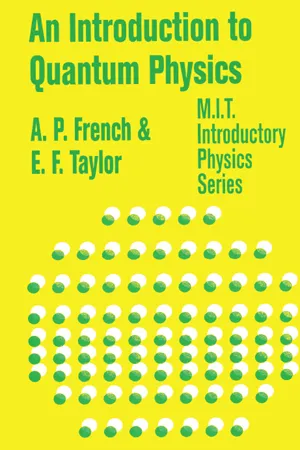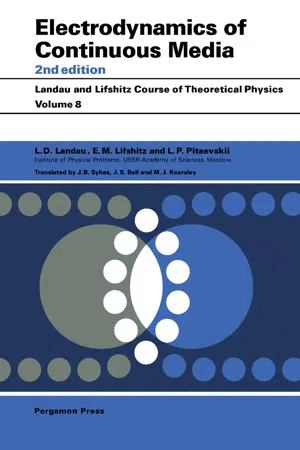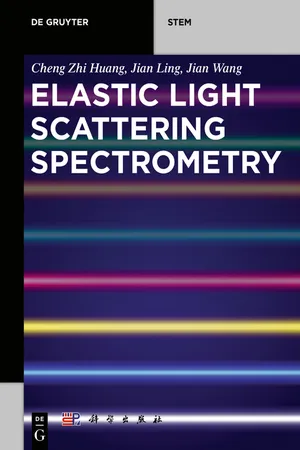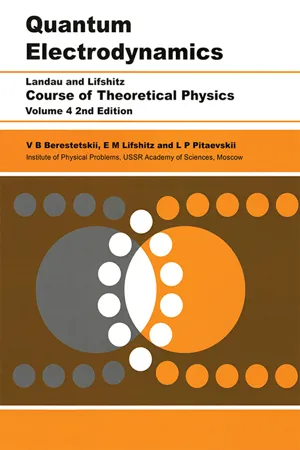Physics
Scattering
Scattering refers to the process in which particles or waves are deflected or redirected as they interact with other particles or obstacles. This phenomenon is fundamental in understanding the behavior of light, sound, and subatomic particles. In physics, scattering is used to study the properties of materials, the structure of atoms, and the behavior of electromagnetic waves.
Written by Perlego with AI-assistance
Related key terms
Related key terms
1 of 4
Related key terms
1 of 3
6 Key excerpts on "Scattering"
- eBook - ePub
- Anupam Garg(Author)
- 2012(Publication Date)
- Princeton University Press(Publisher)
22 Scattering of electromagnetic radiationWhen electromagnetic radiation falls on a medium, the charges in the medium are accelerated and themselves radiate electromagnetic waves. In some cases, dielectrics, e.g., this reradiation combines with the original radiation in such a way as to lead to wave propagation, and the problem is analyzed using the language of the refractive index and the frequency-dependent dielectric function. If instead of a bulk medium, we have a small piece of matter, or even a single charge, the reradiation is said to arise from Scattering of the incident wave. Scattering is an enormously important tool in the analysis of material media, as evidenced by the sheer variety of names: Thomson, Rayleigh, Compton, X-ray, Brillouin light Scattering, Raman, etc. In this chapter, we study some of these.Our task is complicated by the fact that the ultimate description of matter, and even of radiation, must be quantum mechanical. This aspect is especially important when the frequency of the radiation becomes comparable to the internal frequencies of atoms. Absorption and emission then take place at definite spectral frequencies, a fact that classical mechanics cannot explain. Even at low frequencies, the polarizabilites of atoms and molecules must eventually be found by quantum mechanics. At very high frequencies, the quantal nature of light becomes important, as in the Compton effect. Nevertheless, there is a wide range of phenomena where classical physics is applicable, and even where it fails in the details, it provides a valuable way of thinking about the problem.145 Scattering terminology
The basic descriptor of Scattering is the cross section , σ , defined as the power scattered divided by the incident energy flux:FIGURE 22.1. Scattering descriptors.Since the energy flux is the energy passing unit area in unit time, the cross section has dimensions of area. By considering the scattered radiation in an infinitesimal solid angle around a given direction, we obtain the differential Scattering cross section , denoted dσ/d - eBook - ePub
- A.P. French(Author)
- 2018(Publication Date)
- Routledge(Publisher)
9 Particle Scattering and barrier penetration 9-1 Scattering PROCESSES IN TERMS OF WAVE PACKETSMuch of what we know about the structure of atoms and nuclei, and about the interactions between particles, has been derived from the results of Scattering experiments. Particles from accelerators or radioactive sources, for example, are made to impinge on a target containing nuclei to be studied. The interaction between incident and target particles is inferred from the numbers and angular distribution of scattered particles and from their energy distribution. Such experiments are often used to test an assumed form of a potential well by comparing experimental results with the predictions of a quantum-mechanical analysis based on this assumed potential. The quantum-mechanical analysis has a great deal in common with the classical wave analysis of optical processes such as refraction, reflection, diffraction, etc.In general, of course, a particle Scattering process entails a change of direction. It was through the statistical study of such changes of direction that Rutherford (long before the advent of wave mechanics) inferred the properties of the nuclear Coulomb field inside an atom. Scattering in the most general case is a three-dimensional phenomenon, slightly too complicated for this book. However, some of the essential ideas can be more simply presented in terms of hypothetical one-dimensional Scattering processes. Under these conditions, if one ignores the possibility of absorption at the Scattering region, the description of the situation after the interaction has been completed must consist solely of wave packets traveling in the same direction as the incident packet, or else reversed in velocity. - eBook - ePub
- L D Landau, J. S. Bell, M. J. Kearsley, L. P. Pitaevskii, E.M. Lifshitz, J. B. Sykes(Authors)
- 2013(Publication Date)
- Pergamon(Publisher)
CHAPTER XVScattering OF ELECTROMAGNETIC WAVES
Publisher Summary
This chapter discusses the Scattering of electromagnetic waves. Scattering is due to the change in the motion of the charges in the medium under the influence of the field of the incident wave, resulting in the emission of the scattered waves. The basic Scattering process consists in the absorption of the original quantum by the Scattering system and the simultaneous emission by that system of another quantum. The frequency of the scattered quantum may be either less or greater; these two cases are called Stokes Scattering and anti-Stokes Scattering, respectively. In the former case, the system absorbs an amount of energy; in the latter case, it emits energy and makes a transition to a state of lower energy. In the simple case of a gas, Scattering takes place at individual molecules and the change in frequency may be due to either a transition of the molecule to another energy level or to a change in the kinetic energy of its motion. Two types of Scattering can be distinguished, depending on the change in frequency of the light: (1) Raman Scattering and (2) Rayleigh Scattering. Raman Scattering in gases results from a change, due to the incident light, in the vibrational, rotational, or electronic state of the molecule. Rayleigh Scattering, on the other hand, does not involve a change in the internal state of the molecule. - eBook - ePub
High-Intensity X-rays - Interaction with Matter
Processes in Plasmas, Clusters, Molecules and Solids
- Stefan P. Hau-Riege(Author)
- 2012(Publication Date)
- Wiley-VCH(Publisher)
Chapter 3 Scattering of X-Ray RadiationIn this chapter we review the principles of x-ray Scattering. When an electromagnetic wave irradiates an atom or ion, a photon may be absorbed or scattered. If a photon is scattered and its energy is conserved, the photon is said to undergo elastic or Thomson or Rayleigh Scattering. Elastically scattered light is useful for structural investigations using x rays, such as for x-ray crystallography or for coherent diffractive imaging. If the photon transfers energy to the atom and changes its wavelength, it is said that the photon undergoes inelastic, modified, Compton or Raman Scattering. In the first part of this chapter we will describe Scattering of photons by free charges like electrons and nuclei, followed by a description of Scattering by bound electrons, crystals, and plasmas.3.1 Scattering by Free ChargesWe will first review the classical electromagnetic theory for Scattering which is based on the periodic motion of charges in a time-varying electric field that leads to the emission of scattered radiation [1, 2]. The phenomenon of Compton Scattering demonstrates that actual x-ray Scattering does not follow classical electromagnetic theory and needs to be treated in a quantum theoretical framework. Nevertheless, we will still discuss the classical theory since Scattering is often described and tabulated in units of classically derived expressions.3.1.1 Classical Description (Thomson Formula)We consider the case of a monochromatic plane wave with amplitude irradiating a free particle of charge q and mass m located at the origin. E 0 is the electric field vector, and k 0 is the wave vector of magnitude 2π /λ . In vacuum, c = ωλ /2π , where c is the velocity of light, λ is the wavelength, and ω is the frequency. The electric field accelerates the particle, and therefore radiation is emitted. In classical nonrelativistic electrodynamics, the incident and emitted radiation have the same frequency. From Maxwell equations (1.5) to (1.8) it can be derived [3] that the amplitude of the scattered light at a position r far from the particle (r >> λ - eBook - ePub
- Cheng Zhi Huang, Jian Ling, Jian Wang(Authors)
- 2018(Publication Date)
- De Gruyter(Publisher)
Cheng Zhi Huang, Jian Ling, Yuan Fang Li1Introduction to light Scattering
1.1Synopsis of light Scattering
1.1.1Light Scattering phenomenon
Why is the sky blue? Why is the deep sea mazarine? And why is the lake green? All these questions are concerned with light Scattering and its related optical phenomena.Light Scattering is an optical natural phenomenon that exists extensively. Literally, light Scattering refers to a phenomenon that scatters light in all directions. When the light passes through an inhomogeneous medium, photons of different wavelengths interact and collide with the inhomogeneous area of the medium, Scattering the light in different directions. Therefore, the light can be observed in other directions besides the direction of the incident light. For example, in a dark night, when you turn on the electric torch, you can observe the light cross, and this is because the electric torch light is scattered by the suspended particles in the air; hence, the light is visible to our eyes. The larger the particles, the clearer would be seen for these floating particles. It is because of the existence of these particles resulted in Scattering of the electric torch light that the flashlight could not spread to infinity.1.1.1.1Light Scattering acting as an important form of light decay
The same as the light absorption, light Scattering also can make the light passing through a medium decay. For example, when a white light passes through water-diluted milk, in the direction where the light advances, the milk appears pink, while from the side and above, it appears light blue. This is because the white light collides with small particles in milk emulsion, causing variation of different degrees for the light of different wavelengths from the original incidence direction of the white light. A short-wavelength light has more variation, while a long-wavelength light has less variation. - eBook - ePub
Quantum Electrodynamics
Volume 4
- V B Berestetskii, L. P. Pitaevskii, E.M. Lifshitz(Authors)
- 2012(Publication Date)
- Butterworth-Heinemann(Publisher)
CHAPTER VIScattering OF RADIATION
Publisher Summary
This chapter discusses the Scattering of radiation. When the frequency of the incident radiation is less than the energy of the first electron excitation, then the electron terms will not be excited in the Scattering process. The Scattering will be either Rayleigh Scattering or Raman Scattering because of the excitation of rotational or vibrational levels. The Scattering of a photon by a system of electrons consists of the absorption of the initial photon and the simultaneous emission of another photon. The atom may be left either at its initial energy level or at some other discrete energy level. If an atomic energy level is not degenerate, the polarizability and intensity of coherent Scattering are determined by the same tensor. The addition of an imaginary part to the energy levels of the intermediate excited states makes the polarizability tensor no longer Hermitian, even at frequencies below the ionization threshold. It contains an imaginary part, which is directly related to the absorption of radiation. After absorbing a photon, the atom will return to the ground state, emitting one or more photons. The absorption cross section is just the total cross section for all possible Scattering processes. However, according to the optical theorem, the cross section can be expressed in terms of the anti-Hermitian part of the polarizability tensor.§ 59 The Scattering tensor
The Scattering of a photon by a system of electrons (which will be referred to below as an atom) consists of the absorption of the initial photon k and the simultaneous emission of another photon k ′. The atom may be left either at its initial energy level or at some other discrete energy level. In the former case the photon frequency is unchanged (Rayleigh Scattering
Index pages curate the most relevant extracts from our library of academic textbooks. They’ve been created using an in-house natural language model (NLM), each adding context and meaning to key research topics.
Explore more topic indexes
Explore more topic indexes
1 of 6
Explore more topic indexes
1 of 4





